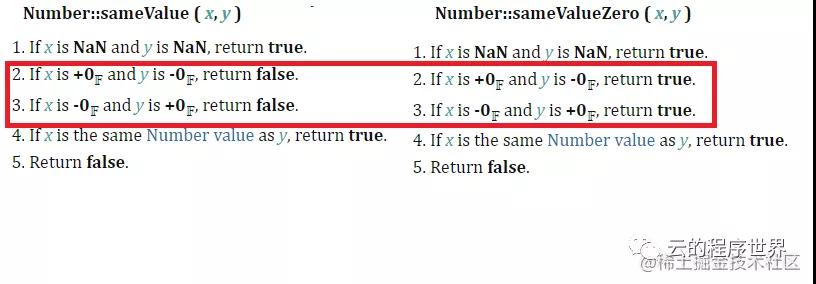NaN和Number.NaN
NaN全称是Not-A-Number,不是一个数字。在 JavaScript 中,整数和浮点数都统称为 Number 类型。
特点1 typeof是数字
口上说不是一个数字,typeof的值却是number, 口是心非。
ES6之后,Number也多了一个静态属性NaN
- typeof NaN // number
- typeof Number.NaN // number
特点2 我不等于我自己
我否定我自己,也就这家了。硬要说,还有一个+0和 -0
- NaN == NaN // false
- Number.NaN == NaN // false
- NaN === NaN // false
- Number.NaN === NaN // false
- +0 == -0 // true
- Object.is(+0, -0) // fasle
NaN的描述信息
其是一个值,新的ES标准中, 不可配置,不可枚举。也就是说不可以被删除delete,不可以被改写, 也不可以改写配置。
- delete NaN // false
- NaN = 1 // 1
- NaN == 1 // false
- delete Number.NaN // false
- Number.NaN = 1 // 1
- Number.NaN == 1 // false
我们尝试改写:
使用Reflect.defineProperty 而不使用Object.defineProperty,因为前者能准确告诉你是否成功,而后者返回的被定义的对象。
- const success =Reflect.getOwnPropertyDescriptor(window, 'NaN'), {
- writable: true,
- configurable: true,
- })
- console.log(success) // false
- Reflect.getOwnPropertyDescriptor(window, 'NaN')
- // {value: NaN, writable: false, enumerable: false, configurable: false}
结果是无法改写,所以不要打他的小心思。
常见的场景
计算, 类型转换是典型的场景
- let print = console.log;
- // parseInt
- print(isNaN(parseInt("zz123"))) // true
- // parseFloat
- print(isNaN(parseFloat("zz123"))) // true
- // 直接Number初始化
- print(isNaN(Number("zz123"))) // true
- // 数字运算
- print(isNaN(0 / 0 )) // true
- print(isNaN( 1 * "zz123" )) // true
- print(Math.sqrt(-1)) // true
isNaN
isNaN() 是一个全局方法。
其本质是检查 toNumber 返回值, 如果是NaN,就返回 true,反之返回 false 。
可以简化为语义:
- Number.isNaN = function (val){
- return Object.is(Number(val), NaN);
- }
toNumber 方法, 大致的逻辑如下:
le 15: ToNumber Conversions
| Argument Type | Result |
|---|---|
| Undefined | Return NaN. |
| Null | Return +0𝔽. |
| Boolean | If argument is true, return 1𝔽. If argument is false, return +0𝔽. |
| Number | Return argument (no conversion). |
| String | Return ! StringToNumber(argument). |
| Symbol | Throw a TypeError exception. |
| BigInt | Throw a TypeError exception. |
关于对象的转换是:
1. Let primValue be ? ToPrimitive(argument, number).
2. Return ? ToNumber(primValue).
简单翻译就是先获取原始类型的值,再转为Number。
取原值,也会根据条件执行不同的方法。
最优先调用 Symbol.toPrimitive, 如果存在
根据条件决定是先调用 valueOf 还是toString
对象这里就比较有意思了, 看下面的例子, valueOf的返回,可以直接影响isNaN的值。
- let print = console.log;
- var person = {
- age: 10,
- name: "tom",
- valueOf(){
- return this.name
- }
- }
- print(isNaN(person)) // true
- let print = console.log;
- var person = {
- age: 10,
- name: "tom",
- valueOf(){
- return this.age
- }
- }
- print(isNaN(person)) // false
常规例子:
- let print = console.log;
- print(isNaN("123")) //false
- print(isNaN('zz123')) //true
- print(isNaN(NaN)) //true
isNaN是可以被删除的,但是不可被枚举:
- delete isNaN // true
- typeof // undefined
- isNaN = 1 // 1
- isNaN == 1 //true
属性描述信息:
Number.isNaN
判断一个值是否是数字,并且值等于NaN.
ES标准的描述:
- If Type(number) is not Number, return false.
- If number is NaN, return true.
- Otherwise, return false.
所有可以语义化为:
- Number.isNaN = function(val){
- if(typeof val !== "number"){
- return false
- }
- return Object.is(val, NaN);
- }
demo:
- let print = console.log;
- print(Number.isNaN(NaN)) // true
- print(Number.isNaN("123")) //false
isNaN和Number.isNaN的区别
Number.isNaN是严格判断, 必须严格等于NaN。是不是NaN这个值
isNaN是通过内部的 toNumber 转换结果来判定的。Number转换的返回值是不是NaN
Number.isNaN是ES6的语法,固然存在一定的兼容性问题。
Object.is
ES6标准新增方法,用于判断两个值是否属于同一个值,其能准确的判断NaN。
- let print = console.log;
- print(Object.is(NaN, NaN)); // true
- print(Object.is("123", NaN)) // false
严格判断NaN汇总
四种,2种ES6, 2种ES5。
- Number.isNaN(NaN) // true
- Number.isNaN(1) // false
Object.is (ES6)
- function isNaNVal(val){
- return Object.is(val, NaN);
- }
- isNaNVal(NaN) // true
- isNaNVal(1) // false
自身比较 (ES5)
最为简单的一种方式。
- function isNaNVal(val){
- return val !== val;
- }
- isNaNVal(NaN) // true
- isNaNVal(1) // false
typeof + NaN (ES5)
这是MDN推荐的垫片,有些兼容低版本的库就是这么实现的, 也是ES标准的精准表达
- function isNaNVal(val){
- return typeof val === 'number' && isNaN(val)
- }
综合的垫片
- if(!("isNaN" in Number)) {
- Number.isNaN = function (val) {
- return typeof val === 'number' && isNaN(val)
- }
- }
深究数组的indexOf与includes
三心酱在50个JS高级知识点有提到 includes能识别 NaN, 我们继续来一看究竟。
- var arr=[NaN];
- arr.indexOf(NaN) // -1
- arr.includes(NaN) // true
includes
我们深入规范看一看:
ES标准的Array.prototype.includes 比较值相等调用的是内部的 SameValueZero ( x, y )方法,其会检查值第一值是不是数字,如果是数字,调用的是 Number::sameValueZero(x, y), 其具体比较步骤:
- 1. If x is NaN and y is NaN, return true.
- 2. If x is +0?? and y is -0??, return true.
- 3. If x is -0?? and y is +0??, return true.
- 4. If x is the same Number value as y, return true.
- 5. Return false.
其先对NaN进行了比较,所以能检查NaN, 这里还有一个额外信息,比较的时候+0和-0是相等的, 要区分+0和-0还得用Object.is
indexOf
ES标准中 Array.prototype.indexOf 值比较调用的是IsStrictlyEqual(searchElement, elementK), 其如果检查到第一个值为数字,调用的 Number::equal(x, y).
其比对逻辑
- 1. If x is NaN, return false. 2. If y is NaN, return false. 3. If x is the same Number value as y, return true. 4. If x is +0𝔽 and y is -0𝔽, return true. 5. If x is -0𝔽 and y is +0𝔽, return true.
- 6. Return false.
可以看到,任何一个为NaN,就直接返回false,必然不能严格的检查NaN.
Number::sameValueZero 和 Number::sameValue
区别
在上个章节我们提到了,Array.prototype.includes值的比较实用的是 Number::sameValueZero , 突出了Zero, Zero是什么,是0啊,也就是说对0进行了特殊的处理。
对应的还要一个 Number::sameValue 方法, 一起看看:
可以看出Number::sameValueZero 不区分+0 -0, Number::sameValue 则区分。
- Object.is(+0, -0) // false, 区分+0,-0
- [-0].includes(+0) // true,不区分+0,-0
BigInt::sameValue和 BigInt:samgeValueZero
图片可以看出,除了Number有, BigInt也有相似的比较。
这两个方法的主要应用场景也就是 Object.is 和 Array.prototype.includes。
再猜猜下面的结果:
- Object.is(BigInt(+0),BigInt(-0))
- Object.is(-0n,0n)
- Object.is(-0,0)
- [BigInt(+0)].includes(BigInt(-0))
3
2
1
结果,不如你所愿:
- Object.is(BigInt(+0),BigInt(-0)) // true
- Object.is(-0n,0n) // true
- Object.is(-0,0) // false
- [BigInt(+0)].includes(BigInt(-0)) // false
哈哈,更多细节 BigInt::equal ( x, y ):
核心解释:
BigInt::sameValue ( x, y ) 调用 BigInt::equal ( x, y )
- BigInt::equal ( x, y )
- 1. If ℝ(x) = ℝ(y), return true; otherwise return false.
而R(x)是啥玩意
- 从 Number 或 BigInt x 到数学值的转换表示为“ x 的数学值”或 R(x)。+ 0F 和-0F的数学值为0
简单的结论:
- Number区分+0,- 0
- BitInt不区分
BigInt::sameValue和 BigInt:samgeValueZero有什么区别呢?
用一张图,更好解释:
没有区别,更合理的解释是什么呢??
小结
indexOf是ES5甚至更早的产物,includes是ES6的产物。高级产物向着更合理化的方向发展,合情合理。
至于为什么不升级indexOf呢,历史包袱吧,以前的代码总不能让其产生意外效果吧。




































